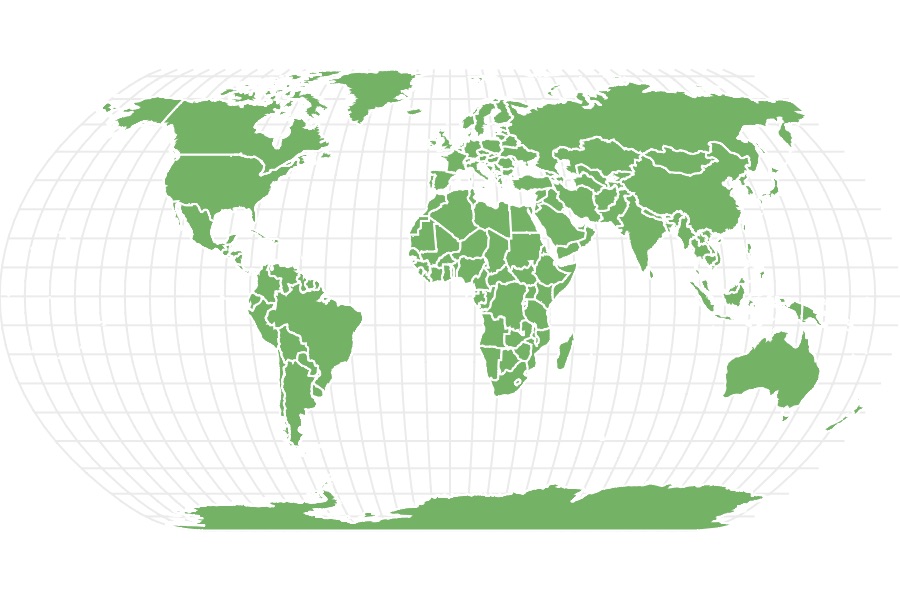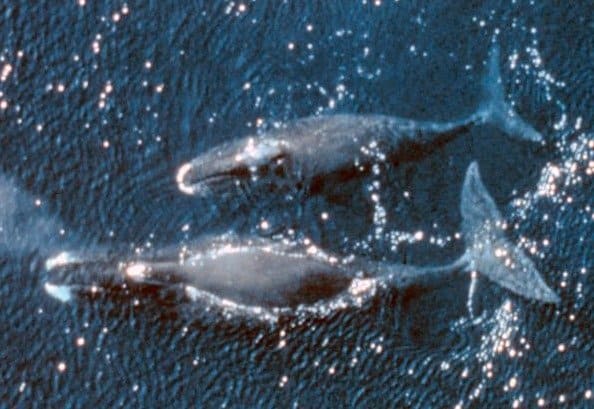Bowhead Whales can make hundreds of distinct songs they use to communicate with one another.
Advertisement
Bowhead Whale Scientific Classification
- Kingdom
- Animalia
- Phylum
- Chordata
- Class
- Mammalia
- Order
- Artiodactyla
- Family
- Balaenidae
- Genus
- Balaena
- Scientific Name
- Balaena mysticetus
Read our Complete Guide to Classification of Animals.
Bowhead Whale Conservation Status

Bowhead Whale Facts
- Prey
- Zooplankton
- Group Behavior
- Solitary
- Pod
- Fun Fact
- Bowhead Whales can make hundreds of distinct songs they use to communicate with one another.
- Estimated Population Size
- 8,000 to 12,000
- Biggest Threat
- Climate change and humans
- Most Distinctive Feature
- Large triangular-shaped skull
- Other Name(s)
- Greenland Right Whale, Arctic Whale, Polar Whale, Steeple-Top, Russian Whale
- Gestation Period
- 13 to 14 months
- Predators
- Killer Whales and humans
- Diet
- Herbivore
- Common Name
- Bowhead Whale
- Number Of Species
- 1
- Location
- Arctic and subarctic waters
View all of the Bowhead Whale images!
Bowhead Whales were given their name because of their very large triangular skull that they use to break through heavy ice to come up for air.
Bowhead Whales live in the very cold Arctic and subarctic waters. Bowheads are believed to be the longest-living mammal; they can live for 200 years or more. They have the largest mouth of any whales and more blubber than any other animal. Bowheads are also sometimes called Russian Whales, Greenland Right Whales, Arctic Whales, Steeple-Tops, or Polar Whales.
5 Incredible Bowhead Whale Facts!
- A Bowhead Whale’s mouth is larger than any other animal’s mouth.
- These whales have the longest lifespan of any mammal. They can live for 200 years or more. Learn about the longest-living animals here.
- Bowhead Whales can use their large and powerful skull to break through ice that is up to 24 inches thick.
- Even though it is quite large, they are able to leap completely out from the water.
- A Bowhead Whale has two blow-holes.
Check out more incredible facts about bowhead whales.
Bowhead Whale Classification and Scientific Name
The Bowhead Whale’s scientific name is Balaena mysticetus. Balaena is the genus of whales that these whales belong to. Mysticetus is derived from the Greek word mystikētos, which means whale. Bowhead Whales are also known as Greenland Right Whales or Arctic Whales. They are also sometimes referred to a Steep-Tops, Russian Whales, or Polar Whales by American whalemen.
Bowhead Whales belong to the Family Balaenidae. There are two genuses in this family. They are Balaena, the genus of Bowhead Whales, and Eubalaena, the genus of Right Whales. Bowhead Whales are in the Mammalia class.
Bowhead Whale Appearance
These whales are dark in color except for their white chin and lower jaw. They were given their name because of their large skull that is nearly triangular in shape. Bowhead Whales use this large and powerful skull to push through the arctic ice and come up for air.
These whale’s baleen, the feeding system inside their mouth, is larger than that of any other whale. It is about 9.8 feet long and allows this whale to catch and strain very small prey in the water.
Another unique feature of a Bowhead Whale is that they have a pair of blow-holes. These blow-holes are located at the tip of their head and are capable of spouting water up to 20 feet high. These whales also have the thickest blubber of any animal. Their blubber can be up to 20 inches thick.
While most whales and other cetaceans have dorsal fins, the Bowhead Whale does not. This is an adaptation that allows this species to spend more time beneath ice on the surface of the water.
Bowhead Whales have an average length of 50 to 60 feet. They typically weigh between 75 and 100 tons. Females are typically larger than males.

Two bowhead whales
©NOAA Photo Library / public domain – License
Bowhead Whale Distribution, Population, and Habitat
These whales live in the cold Arctic and subarctic saltwater water. Their exact range and location can vary based on how much ice has formed or melted due to climate changes. They can be found a bit farther south during the winter months but will head north when ice begins breaking up or receding in the spring. This species can be found in the Hudson Bay, Foxe Basin, Bering Sea, Beaufort Sea, Chukchi Sea, Davis Strait, Baffin Bay, Sea of Okhotsk, and the water between eastern Siberia and Greenland/Spitsbergen. They typically don’t dive too deep beneath the surface. They may go up to 500 feet beneath the surface at times, though.
It is not completely clear what the exact population of the Bowhead Whale is, but it is estimated that there are between 8,000 and 12,000 members of this species left. The global population has a conservation status of Least Concern. There are five different Bowhead population stocks located in different areas.
One stock can be found in the Baffin Bay and Davis Strait. It is estimated that there are about 14,400 whales in this stock. The number of Whales in the Western Arctic Stock has been growing each year by about 3.7%. It is estimated that the number of whales in this stock may be almost back to its pre-whaling levels.
The Hudson Bay and Foxe Basin stock of these whales likely has a population of about 500 or 600. The population of the Svalbard-Barents Sea stock is currently unknown, but this stock is considered endangered due to a drastic decrease in the number of whales over the years. The Sea of Okhotsk stock is another endangered group of Bowhead Whales. There are probably less than 400 whales left in this stock.
Bowhead Whale Predators and Prey
What Threatens the Bowhead Whale?
These whales do not have many natural predators due to their large size. A pod of Killer Whales may sometimes prey on a Bowhead Whale.
Humans are the greatest threat to Bowhead Whales. Before commercial whaling was ended, the population of these whales saw a significant decrease. They are hunted for their meat, blubber, baleen, bones, and oil. As a slow swimmer who floats when dead, they were often targeted by commercial whalers. Currently, these whales are hunted by a small population of native people in North America, but nowhere near the levels they were hunted during the days of commercial whaling.
What Do Bowhead Whales Eat?
These whales east amphipods, crustaceans, copepods, and other zooplankton. Each day, they eat about two short tons of food. The mouth of the whale consists of hundreds of plates of baleen that overlap one another. The baleen works to filter food from the water that passes through it as the whale swims. Prey becomes trapped inside the baleen close to the whale’s tongue, where they’ll be able to swallow it. Animals that use this method of feeding are known as filter feeders.
Bowhead Whale Reproduction and Lifespan
It is estimated that these whales reach sexual maturity somewhere between the ages of 10 and 15. Their breeding season takes place from March to August, though it is most likely that conception takes place in March since this is when there is the greatest amount of song activity. Bowhead Whales may engage in sexual activity in pairs or in a group that is made up of numerous males and just one or two females.
Female Whales typically give birth to a live calf about every three or four years. The gestation period is about 13 or 14 months long. After a calf is born, it will nurse for about a year.
Bowhead calves are capable of swimming independently within 30 minutes of being born. The calves are between 13 and 15 feet and weigh about 2,200 pounds at birth. By the end of their first year of life, they will be about 27 feet long. Since these whales live in the cold Arctic waters, calves are born with a very thick layer of blubber to keep them warm.
The exact lifespan of these whales is unknown, but scientists believe they are the longest-living mammal. Many Bowhead Whales may live to be over 200 years old. Researchers from Australia’s National Science Agency hypothesized that the longest a Bowhead Whale could live is 268 years due to their genome sequence.
Bowhead Whale in Fishing and Cooking
It is illegal to hunt these whales in most areas. The Iñupiat and St Lawrence Island Siberian Yupik, two native Alaskan groups, are permitted to hunt them on a subsistence level. This means they are only allowed to hunt small numbers of whales to support their populations.
These groups do use the meat and blubber from the whales in cooking. Muktuk is one meal made from the skin and blubber of a Bowhead Whale. Traditionally, this meal was eaten raw, but now it may also be deep-fried.
View all 285 animals that start with BBowhead Whale FAQs (Frequently Asked Questions)
Where are Bowhead Whale found?
Bowhead Whales live in the Arctic or subarctic waters. There are five different stocks of Bowhead Whales that can be found in different areas: The Western Arctic stock (the Bering, Beaufort, and Chukchi Seas), the Hudson Bay and Foxe Basin stock, The Sea of Okhotsk stock, the Baffin Bay and Davis Strait stock, and the Svalbard-Barents Sea stock.
How long does a Bowhead Whale live?
The exact lifespan of a Bowhead Whale is unknown, but many will live for 200 years or more.
How big is a Bowhead Whale?
Bowhead Whales are typically between 50 and 60 feet long and weigh between 75 and 100 tons.
How many Bowhead Whales are left in the world?
There are probably between 8,000 and 12,000 Bowhead Whales left in the world.
What eats a Bowhead Whale?
Killer Whales may work together to hunt and eat a Bowhead Whale. Some native groups also hunt Bowhead Whales and eat their skin, meat, and blubber.
How much does a Bowhead Whale weigh?
Bowhead Whales weigh between 75 and 100 tons.
Are Bowhead Whales herbivores, carnivores, or omnivores?
Bowhead Whales are Herbivores, meaning they eat plants.
What Kingdom do Bowhead Whales belong to?
Bowhead Whales belong to the Kingdom Animalia.
What phylum do Bowhead Whales belong to?
Bowhead Whales belong to the phylum Chordata.
What class do Bowhead Whales belong to?
Bowhead Whales belong to the class Mammalia.
What family do Bowhead Whales belong to?
Bowhead Whales belong to the family Balaenidae.
What order do Bowhead Whales belong to?
Bowhead Whales belong to the order Artiodactyla.
What type of covering do Bowhead Whales have?
Bowhead Whales are covered in Tough skin.
What is the scientific name for the Bowhead Whale?
The scientific name for the Bowhead Whale is Balaena mysticetus.
How many species of Bowhead Whale are there?
There is 1 species of Bowhead Whale.
What is the biggest threat to the Bowhead Whale?
The biggest threats to Bowhead Whales are climate change and humans.
How do Bowhead Whales have babies?
Bowhead Whales give birth to live young.
Thank you for reading! Have some feedback for us? Contact the AZ Animals editorial team.
Sources
- Wikipedia, Available here: https://en.wikipedia.org/wiki/Bowhead_whale
- WWF, Available here: https://www.worldwildlife.org/species/bowhead-whale
- Merriam Webster, Available here: https://www.merriam-webster.com/dictionary/Mysticeti#:~:text=New%20Latin%2C%20plural%20of%20mysticetus,%2C%20the%20whale%20so%20called%E2%80%9D)
- Oceanwide Expeditions, Available here: https://oceanwide-expeditions.com/to-do/wildlife/bowhead-whale#:~:text=Do%20Bowheads%20Whales%20have%20any,face%20is%20the%20Killer%20Whale.
- Enchanted Learning, Available here: https://www.enchantedlearning.com/subjects/whales/species/Bowheadwhale.shtml#:~:text=It%20is%20estimated%20that%20there,whales%20are%20an%20endangered%20species.&text=Bowhead%20whales%20(Balaena%20mysticetus)%20are,baleen%20whales%20(Suborder%20Mysticeti).
- Arctic Kingdom, Available here: https://arctickingdom.com/10-fun-facts-about-bowhead-whales/
- NOAA Fisheries, Available here: https://www.fisheries.noaa.gov/species/bowhead-whale#overview
















